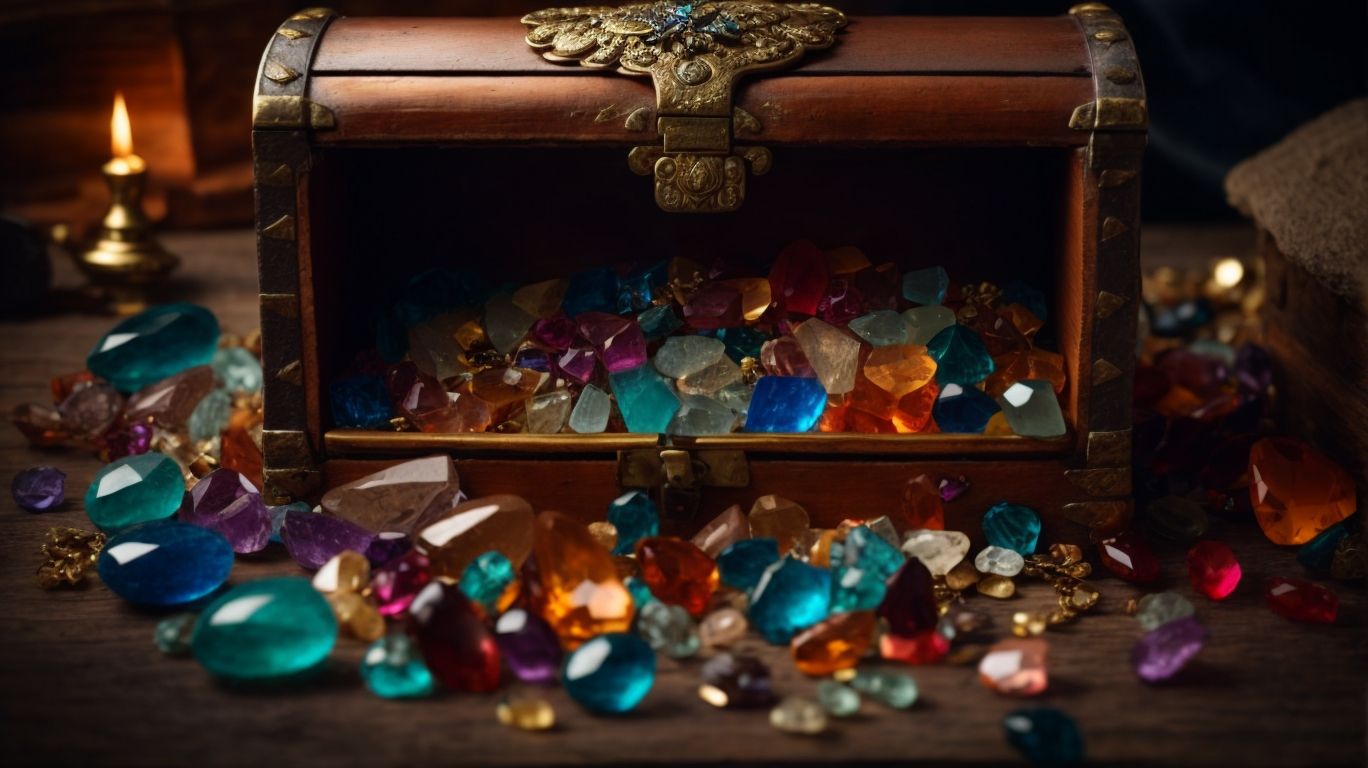
Timeless Treasures: Exploring the Role of Gemstones in History
Gemstones have captivated human beings for centuries, holding a special place in history as timeless treasures.
From ancient civilizations to modern-day economies, these precious stones have played a significant role in shaping cultures, beliefs, and economies around the world.
We will delve into the rich history of gemstones, exploring their significance in ancient civilizations, their symbolism in birthstones and folklore, their role in royal families, and their impact on trade and economy.
Join us on a fascinating journey through the world of gemstones.
The History of Gemstones
Gemstones have played a significant role throughout history, being revered as timeless treasures by ancient civilizations for their cultural importance, symbolic meanings, and precious qualities.
They were often used for adornment and as status symbols, showcasing wealth and power among the elite. In ancient Egypt, gemstones like lapis lazuli and turquoise were associated with deities and believed to have protective qualities. The Romans valued gemstones for their supposed medicinal properties, using them in amulets and talismans. Across different cultures and historical periods, gemstones have been linked to spiritual beliefs, rituals, and even used in burial practices to ensure safe passage to the afterlife.
Ancient Civilizations and Gemstone Beliefs
Ancient civilizations held profound beliefs about gemstones, considering them as timeless symbols of power and beauty that adorned decorative objects and influenced fashion trends.
These civilizations believed that specific gemstones possessed unique properties that could bring good fortune, protect against evil forces, or even grant the wearer enhanced spiritual abilities.
For example, the deep blue lapis lazuli was associated with royalty and the divine, while the vibrant green emerald symbolized rebirth and fertility.
The use of gemstones in jewelry and ceremonial objects was a way to harness the energies and meanings attributed to each stone, creating a deeper connection between the wearer and the natural world.
The Rise of Gemstones in Jewelry
The incorporation of gemstones in jewelry marked a significant cultural shift, with each gemstone carrying its own symbolism, legends, and becoming a canvas for wearable art in the world of fashion.
Throughout history, gemstones have captivated humanity with their mesmerizing beauty and intrinsic meanings. From ancient civilizations to modern-day designers, gemstones like rubies, emeralds, and sapphires have held symbolic significance, believed to bring luck, protection, and healing properties.
Legends and folklore have intertwined with these precious stones, adding a mystical allure to jewelry adorned with them. As time progressed, gemstones not only influenced fashion trends but also transcended to becoming avant-garde art pieces, with designers pushing the boundaries of creativity by incorporating these gems into innovative and stunning jewelry creations.
Gemstones in Religion and Mythology
Gemstones have held a sacred place in religion and mythology, embodying spiritual beliefs, carrying symbolic meanings, and being central figures in legends and myths that transcend time.
Across different cultures and faith traditions, gemstones are believed to possess unique energies and powers, reflecting the divine through their vibrant hues and formations.
In Hinduism, for instance, gemstones are associated with specific planets and chakras, believed to enhance spiritual growth and balance.
In ancient Egypt, gemstones were intricately connected to the afterlife, with precious stones like lapis lazuli symbolizing protection and wisdom for the deceased.
The Bible also references gemstones, with each stone in the High Priest’s breastplate holding symbolic significance related to various virtues and divine attributes.
The Symbolism of Gemstones
Gemstones are imbued with deep symbolism, ranging from birthstones that hold personal meanings to gemstones believed to possess healing properties and those steeped in superstitions and folklore.
These precious stones have a long history of not just being admired for their beauty, but also cherished for their deeper significance in cultures around the world. Birthstones, for example, are often linked to an individual’s birth month, with each stone representing unique traits and characteristics for those born during that time.
Many people turn to certain gemstones for their perceived healing properties, with crystals like amethyst thought to promote clarity of mind and inner peace. Various gem varieties have been associated with superstitions and folklore, such as the belief that wearing a specific gemstone can bring luck or ward off evil spirits.
Birthstones and Their Meanings
Birthstones hold special meanings based on individuals’ birth months, with each gemstone on the birthstone chart carrying unique symbolic significance and personal connections.
These gems have been cherished for centuries, believed to bring luck, protection, and spiritual benefits to those who wear them.
For instance, January’s garnet is associated with love, passion, and energy, symbolizing the enduring commitment and dedication.
February’s amethyst signifies peace, courage, and clarity of mind, fostering a sense of inner peace and emotional stability.
As individuals learn about their birthstone’s properties and meanings, they often feel a deep connection to the stone’s attributes, influencing them in various aspects of life.
Healing Properties of Gemstones
Gemstones are believed to possess various healing properties based on their metaphysical characteristics, drawing on the principles of gemology to understand their effects on physical and emotional well-being.
These gemstones are thought to interact with the body’s energy fields, known as chakras, to promote balance and enhance vitality. For example, amethyst is associated with calming qualities, believed to reduce stress and promote relaxation, while citrine is said to bring abundance and positivity into one’s life.
Different gemstones are often recommended for distinct purposes; for instance, rose quartz is connected with matters of the heart, supporting love and emotional healing. The study of gemology delves into the properties of minerals and crystals, shedding light on how these precious stones are thought to influence various aspects of health and wellness.
Superstitions and Folklore Surrounding Gemstones
Gemstones have been shrouded in superstitions and folklore, with each gem carrying its own symbolic weight, intertwined with legends and myths that have been passed down through generations.
For centuries, people have believed that certain gemstones possess unique powers or meanings, influencing various aspects of life. Take, for example, the ruby, revered for its association with love and passion, while the emerald is often linked to rebirth and growth. These beliefs stem from ancient tales and cultural traditions, with gemstones becoming more than just mere decorative pieces. From providing protection to bringing good luck, the symbolic significance attached to gemstones continues to fascinate and enchant individuals worldwide.
The Role of Gemstones in Royal and Noble Families
Gemstones have long played a central role in the lives of royal and noble families, with famous gemstone collections serving as testaments to their wealth, power, and exquisite taste in gemstone jewelry.
These precious stones have not only been cherished for their stunning beauty but also for the symbolism they inherently carry in aristocratic circles. Gemstone jewelry was often used as a way to showcase one’s status, power, and connections within royal families.
The historical significance of gemstones can be seen in the exquisite pieces passed down through generations, each stone holding its own story of opulence and prestige. The cultural impact of gemstones in aristocratic circles extends beyond mere adornment, reflecting the sophistication and grandeur of the noble lineage that possessed them.
Famous Gemstone Collections
Royal and noble families have amassed famous gemstone collections that are steeped in history, luxury, and are often showcased in exquisite gemstone jewelry pieces that exude opulence and tradition.
These gemstone collections, passed down through generations, serve as a testament to the grandeur and heritage of the royal and noble houses. In addition to their monetary value, these gemstones hold deep cultural significance, representing power, status, and influence within the families.
Each jewelry piece crafted with these precious gemstones tells a story of dynasties and legacies, showcasing craftsmanship and design that reflect the artistic sensibilities of the era in which they were created. The display of these collections in museums and exhibitions provides a glimpse into a world of luxury and history intertwined.
Gemstones in Royal Regalia
Gemstones have adorned royal regalia for centuries, enhancing the splendor of royal attire and reflecting the fashion trends of each era through their exquisite gemstone jewelry designs.
These precious stones have played a pivotal role in symbolizing power, wealth, and status within royal circles. For centuries, royals worldwide have utilized gemstones to create intricate and opulent pieces of jewelry, from sparkling tiaras to dazzling necklaces. The use of specific gemstones also holds historical and cultural significance, with each stone conveying different meanings and messages.
The evolution of gemstone jewelry designs in royal settings showcases a fusion of traditional craftsmanship with contemporary aesthetics, setting trends that are often emulated across the fashion world.
The Impact of Gemstones on Trade and Economy
Gemstones have wielded a significant impact on trade and economy, serving as valuable commodities that drive the gemstone industry, fuel gemstone mining operations, and shape the dynamics of the gemstone market.
Their allure extends beyond mere aesthetics; gemstones are highly sought after for their investment value, symbolism, and cultural significance. This demand has led to the establishment of intricate global supply chains, linking mining sites in various countries to cutting and polishing centers and ultimately to retail markets around the world. As consumer preferences shift and new markets emerge, the gemstone industry adapts, introducing innovative mining techniques and sustainable practices to meet evolving demands while ensuring the longevity of this unique sector.
Gemstones as Currency
Throughout history, gemstones have functioned as valuable currency, facilitating trade routes, shaping the gemstone market, and symbolizing wealth and power across diverse cultures.
These precious stones, such as diamonds, rubies, and emeralds, were used as a form of payment in ancient civilizations, allowing merchants to exchange goods along established trade routes. This widespread acceptance of gemstones as a medium of exchange not only boosted commerce but also influenced the gemstone market by dictating value based on rarity and desirability. Gemstones carried symbolic significance, often adorning the elites as symbols of their status and influence within society.
Gemstone Mining and Trading
Gemstone mining and trading are vital components of the gemstone industry, driven by the pursuit of rare gemstone varieties, ethical practices, and the conservation of gemstone resources.
The process of gemstone mining involves rigorous exploration and extraction methods to uncover these precious natural treasures beneath the earth’s surface. Miners often face challenging conditions as they dig deep into mines, applying specialized techniques to find and retrieve gemstones.
Interestingly, sustainability has become a significant focus in the industry, with many companies adopting eco-friendly practices to minimize environmental impact and ensure the long-term viability of gemstone sources. This commitment to sustainable mining not only safeguards the environment but also enhances the reputation of the gemstone trade as conscientious stewards of the earth’s resources.
The Gemstone Industry Today
The contemporary gemstone industry is shaped by market trends, ethical practices, sustainability initiatives, and conservation efforts aimed at preserving the integrity of gemstone sources and ensuring the industry’s longevity.
Trends in the gemstone market are constantly evolving as consumer preferences shift towards ethically sourced and sustainable gemstones. Ethical considerations play a crucial role in shaping consumer behavior, with a growing demand for transparency in the supply chain. Sustainability measures are becoming increasingly important, leading to initiatives such as responsible mining practices and community development projects in mining areas. Conservation initiatives are also gaining momentum, with efforts to protect natural habitats and wildlife affected by gemstone extraction activities.




No Comments